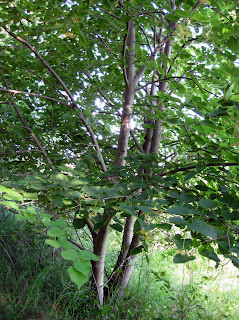American Basswoods, about ten years after being transplanted from the wild
Memory:
I follow my father as he uses the big scythe to cut the tall weeds near the garden. I want to help but I am too little to handle the scythe."Stay back or go back to the house!" he says to me a second time.
I follow at a safe distance, stepping over stiff weed stubble. Mosquitoes fly into my ears and nose. I use my cap to swat them away. Dad stops to use his cap to swat mosquitoes and I suddenly see him grin widely, inhale deeply, and then grin even wider.
"Smell that, Son? That's the big basswood in blossom."
I inhale deeply the sweet, heavy fragrance until I taste the odor in my mouth.
"Come here, once," he says and I follow him a short distance. Together we stare at the tree's blossoms, thick with honey bees.
"It makes great honey," he confides to me.
Several years ago when we knew the farmstead would be replaced by a development, my wife Nancy and I struggled to dig out a few small basswoods from that same space where the big one used to stand. We planted them in our yard and now every June I inhale that same sweet, heavy fragrance until I taste the odor in my mouth.
Bees have finished with the blossoms, but the fragrance remains strong.
Left on their own in the wild, the American Basswood will usually have multiple trunks.
These two were transplanted about the same time as the trees in the top pictures, but these were not pruned to one trunk.
Sure, I know fancy landscapers and city planners prefer to plant the European version with its smaller leaves and tighter crown, but I prefer the big, handsome American Basswood to the Little Leaf Linden.
I guess it's just my history.
Photographs by Nancy A. Fredrickson








No comments:
Post a Comment